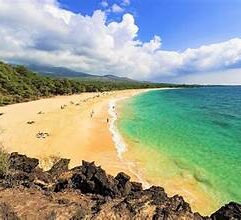No products in the cart.
Maui, HI
Maui Lush rainforests, black-sand beaches, waterfalls cascading into deep-blue lagoons—Maui is a place where nature really shows off. Wake up early to catch the sunrise on Haleakalā, then stay to explore hiking trails and otherworldly volcanic formations at Haleakalā National Park. Take a drive on the winding Road to Hana to discover untouched beaches (with unbelievable coastal views along the way), or hop on a boat and go whale-watching or snorkeling.
If you’re looking for something more low-key, pick up a plate lunch or some fish tacos and spend a do-nothing day at Ka’anapali Beach, then check out the cliff-diving ceremony at sunset. Go big on adventure, or kick back on a quiet shore—it’s up to you, and we’ve got more recs below.
Things to see and do in Maui
- Haleakala Crater
- Hana Highway – Road to Hana
- Maui Pineapple Tour
- Haleakala National Park
- Pipiwai Trail
Some things that are worth trying out:
Place to Eat
Typical costs when traveling
A typical one-week Maui trip, including flights, accommodation, transportation, activities, and food, can range from $2,000 to $5,000 per person. More detailed estimates for a week-long trip include: $3000-$3500 for a couple with daily expenses around $200-$250. For a 10-night trip, a four-star beachfront resort with a rental car could cost around $15,090, while a low-cost condo with tightly budgeted meals and a rental car might cost around $7,781.
Accommodation:
- Budget: You might find affordable condos or hotels within walking distance of the beach for a few hundred dollars per night.
- Mid-Range: Three-star hotels or condos with more amenities could cost around $300-$600 per night, according to collectionsofwaikiki.com.
- Luxury: Four-star beachfront resorts can easily exceed $600 per night.
Food:
- Dining Out: Expect to spend $15-$25 per person for lunch and $30-$50 per person for dinner at restaurants, according to Maverick Helicopters.
- Grocery Shopping: Shopping at local stores like Costco, Walmart, or Times Supermarket can help save money on meals.
Transportation:
- Rental Car: A rental car for a week can be a significant expense, but it provides flexibility to explore the island.
- Public Transportation: Maui does have some public transportation options, but they may not be as convenient for exploring the island.
Do’s and Don’ts
In Maui, it’s important to respect the environment and local culture. Do use reef-safe sunscreen, be mindful of wildlife, and stay on designated trails. Don’t touch marine life, leave trash behind, or take natural items as souvenirs.
Do’s:
- Respect the environment: Stay on marked trails, avoid stepping on coral reefs, and dispose of trash properly.
- Protect wildlife: Do not touch, feed, or harass sea turtles or other marine life.
- Be mindful of locals: Pull over to let others pass on narrow roads, and leave shoes at the door when entering someone’s home.
- Explore responsibly: Snorkel and enjoy the local culture, but avoid areas with blow holes or designated off-limits areas.
Don’ts:
- Don’t touch marine life: It’s illegal and harmful to marine life.
- Don’t leave trash: Pick up after yourself and leave the environment as you found it.
- Don’t take natural items as souvenirs: This can be bad luck and harm the environment.
- Don’t wander off-trail: Stay on designated paths to avoid getting lost and protect the ecosystem.
- Don’t ignore ocean warning signs: Be aware of strong currents and other hazards.


Leave a Reply